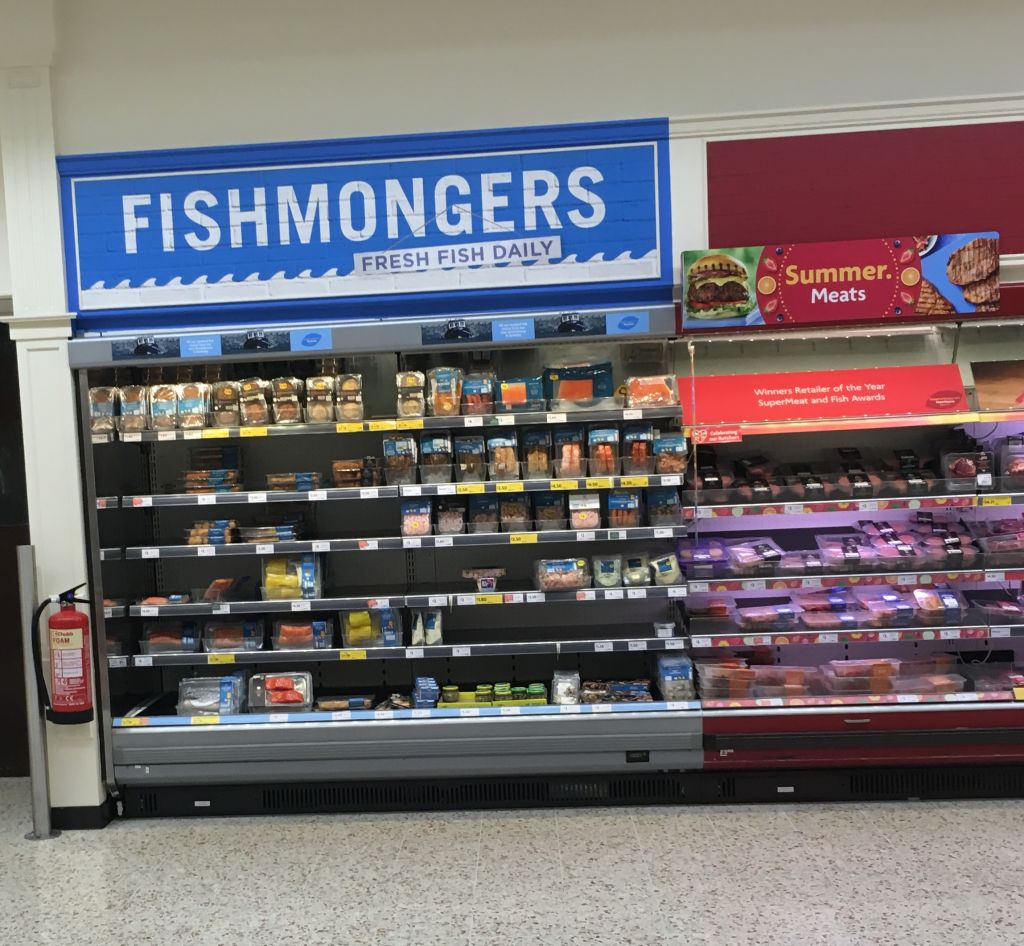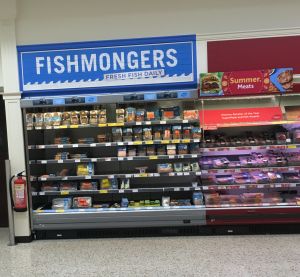Easter boost: Intrafish report that, according to Seafish, the UK saw a huge growth in seafood sales over the Easter holidays with lobster the star performer. There was a massive 83% uplift in sales of lobster amounting to over 6,700 kilograms as consumers shelled out for premium seafood. In total shoppers spent an extra £9 million over Easter buying over 470,000 kilograms of additional seafood. Other popular species included salmon, cod, tuna, pollock and haddock which Seafish say ensured that shoppers were eating their 2 portions of fish a week.
We, at Callander McDowell must presume that these lobster sales must have been made through specialist fishmongers because there was little evidence of lobster on the supermarket fish counter. Easter was early this year occurring at the end of March. The main promotions were either whole salmon or cod fillet/loin.
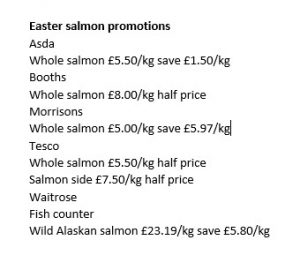
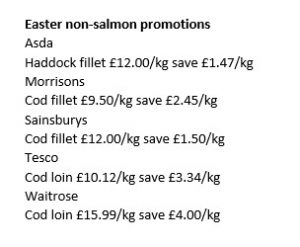
We were reminded that a similar positive message was given for Easter 2017 with the Aquaculture Directory reporting that sales had been the highest over Easter for the previous three years with 605,106 kilograms of seafood sold during the fortnight from 8 to 22 April, up 3.2% since 2015. The most popular species were warmwater prawns, basa, mackerel, crabsticks, sea bass, pollock, haddock, sardines and whitebait. Notable absences from this list were cod and salmon despite being heavily promoted over the Easter period. Surprisingly snapper saw the biggest increase in volume sales compared to the two weeks before Easter with a 75% rise, although this was from 1,500 kilos to 2,700. Snapper was virtually absent from the main supermarket counters.
In 2016, Undercurrent News reported that seafood sales soared over Easter with an overall increase of 6.5% over the two weeks of Easter compared to the two previous weeks.
Seafish told Intrafish that sales are expected to rise over Easter, but that volume has slowly declined over the last three years. Since 2015, volume has dropped by nearly 2 ,000 tonnes due to price rises per kilogram.
However, Seafood Source report that a new survey commissioned by Seafish found UK consumers spent £7.7 billion on fish and seafood in 2017. This is up 16.7% from 2016. Of this £3.73 billion was spent at retail for home consumption; an increase of 5.1%.
The problem with measuring consumption by value is that values can change quite rapidly due to either rising or falling prices as well as such things as currency fluctuations. Volume gives a much better indication of changes in consumption and according to Seafish, high prices meant that multiple retail sales fell by 3.2% year on year to 316,000 tonnes. This includes chilled, frozen and ambient such as canned. Of these, only chilled and fresh fish showed an increase with sales rising by 11.8%. By comparison, ambient sales fell by 42% and frozen by 24%.
These very broad figures are difficult to translate into an appreciation of how consumption patterns are changing. Seafish have also quoted figures from DEFRA which relate to consumption per person. This is an interesting development because in the past, the DEFRA figures have been largely ignored by the wider industry, probably because declining consumption is not something that anyone wants to hear. Now they confirm what is happening elsewhere.
The latest DEFRA figures for at-home fish consumption were published last month and were not great. Consumption fell in the last year from 144g to 135g per person per week. This equates to every person in the UK eating three portions of fish less per year than a year ago and thirteen portions less than in 2006, when consumption last peaked.

In our view, the plateau from 2012 to 2015 was caused by some hard discounting of cod in stores, which occurred week in and week out. The main purchasers of these deals were the over 50’s. One fishmonger told us at the time that cod was an old person’s fish!
Seafish attribute the recent decline to be in direct proportion to rising prices but we are not so sure. For many years, fish consumption patterns have been something of a roller-coaster ride. In the 1970’s for example, consumption fell to just 118g per person per week. This low coincided with the height of the cod wars between Britain and Iceland. It is therefore not always about price.
Whilst it is of concern that at-home consumption has fallen to 135g per person per week, the underlying trends may be a lot worse. The DEFRA figures include all fish and seafood bought for home consumption. This includes frozen and ambient as well as fish ready meals. If fresh and chilled fish, the section which is seemingly doing well, is considered separately, then consumption is less than 30g per person per week. This equates to just less than one portion of fish per person per month, far short of the two portions of fish per week. If all at-home fish consumption is included, then consumption works out at about one portion per person per week. However, this has to be offset against the fact that sales of fish eaten out of the home is increasing. What appears to be happening is that consumers are happy to eat fish cooked for them out of the house but less happy to cook fish at home for themselves. This is noticeable at the supermarket where counters are shrinking in size as consumer visits decline. Even packs of chilled fish are not as widespread as they used to be.
We were once told by an industry stalwart that consumption has risen and fallen at various times in history and that there is nothing really new in what is happening to consumption now. Yet, shopping habits are changing, and these will have a major impact on fish sales.
The biggest change is the decline of the wet fish counter. Consumers have appeared to prefer fish in prepacks for several years now but as the UK public move away from making a weekly shop in the large supermarket to the much smaller express store, the range of fish on offer is likely to shrink as fish will have to fight for limited shelf space. Consumers like eating the Big Five species – cod haddock, salmon, tuna and prawns – but in the future, the Big Five maybe all that is on offer. Seafish have said that whilst consumers are comfortable with their favourite species, there is so much more that they could eat. This is unlikely unless there is a radical rethink on the way that fish is presented to consumers because they will never choose to eat what they cannot see.
Fish consumption is changing. It may not be that long before fish is something that is eaten out of the home and never cooked in the home. It may happen even quicker than we think.
Don’t cook, won’t cook: The Daily Mail recently reported that Britons may forget to cook within two generations with more people relying on ready meals and takeaways. Science writer Nicola Temple told the Edinburgh International Science Festival that other than the weather, Britons like to talk about how busy they are, yet the average person watches three and a half hours of TV every day, so it is more likely that Britons are not too busy to cook, they simply just don’t want to. If these trends continue, she says it is likely that the ability to cook will die out. She said that once everyone could sew, but now what was once a necessity, is no longer so.
In addition, Mrs Temple pointed out that there are many more single person households and single people are less likely to bother making meals. The average person now spends 34 minutes cooking an evening meal compared to the 1980’s, when it was an hour. However, more worryingly a survey of millennials conducted by the Co-op found that a quarter are not interested in learning how to cook. With the emergence of Deliveroo and Just Eat, more consumers simply opt to order in food.
None of this comes as any surprise to us At Callander McDowell. We have been watching changes to the retail sector over the last twenty years and have seen major changes to the fish and seafood offering over this time. The most obvious trend is the decline in space in major retailers devoted to fish and seafood. This was hit home to us again this week when we visited a branch of Morrisons supermarkets that is a little outside our survey area. This is a fairly large store with a café and a homewares section. It has all the usual service counters including butchers, bakery, deli and oven fresh (cooked chicken etc) but surprisingly no fishmonger. We say this is surprising because Morrisons fish counters tend to be some of the best in the retail sector and every large store we have visited has one. The absence of the fish counter would suggest a reasonable chilled fish section but what we found was one of the smallest fish sections in a large Morrisons store. Even stores with a counter usually have a larger chilled fish section. Clearly, shoppers in this particular area have already stopped buying fish for home consumption.
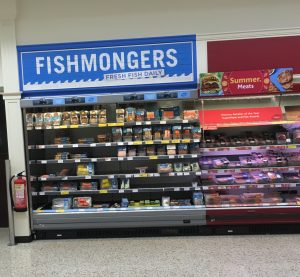
Chip off the block: National Fish and Chip Shop day was held at the beginning of the month and according to the Sun newspaper this was a celebration of glorious fried fresh fish with succulent chips and lashings of vinegar. The festival aims to promote all those involved in the fish and chip chain, from fishermen to farmers to the restaurants and fish and chip shops that sell them to the public.
The Federation of Fish Friers provided some fishy facts including that there are about 10,500 fish and chip shops in the UK. These outnumber McDonalds who have 1,200 stores and Kentucky Fried Chicken who have 840. Finally, 22% of people visit fish and chip shops every week
By coincidence, ‘Fish on Friday’ have just published details of a survey conducted by DLM Distributions, a leaflet distribution company (responsible for a lot of the take-away menus posted through letterboxes). They have found that fish and chips is one of the least desired takeaway meals with just 7% of customers choosing to buy them. By comparison, Chinese meals are preferred by 35% followed by Indian food at 24% and pizza at 13%.
DLM found that just 30% of consumers are now prepared to travel to a takeaway food shop to order and collect their food with the majority opting to use the telephone or online. This is perhaps one of the reasons why fish and chips may be losing out to ethnic food as traditionally, consumers have to queue up for their fish and chips (depending on the popularity of the individual shop). Whilst fish and chips may be considered the national dish and a traditional staple meal choice, perhaps, fish and chip shops need to embrace newer methods of accessibility in line with other choices.
In our locality, fish and chips are now available for delivery by Deliveroo which means we and our neighbours can select fish and chips in exactly the same way as we can any other takeaway food choice.
French too: Fishupdate.com reports that the popular perception of France as a nation with an insatiable appetite for anything that comes out of the sea has suffered a setback. A new survey from the Norwegian Seafood Council has found that the French are now amongst the lowest consumers of seafood in Europe. Only a third of French consumers eat the recommended diet of two or more seafood meals a week. The Portuguese eat most with 75% of consumers eating 2 portions a week followed by Norway at 71%, Spain at 67% and Japan at 60%. France is second to last at 34% with Germany at 31%. Th survey found that consumption has been in decline since 2011 but we, at Callander McDowell believe that the decline started well before that.
The NSC survey found that although consumption has fallen, the French are looking for higher quality seafood and more shoppers are warming to farmed fish. Thirty one percent of consumers say that they would now be happy to eat farmed fish.
Like most surveys, what consumers say and what they do can be two very different things. It is only necessary to look at the offerings on typical fish counters to see that French consumers are happily buying and eating a range of farmed fish and seafood. We can only assume that they don’t really know that. We are equally not convinced that consumers are looking for higher quality seafood if it means paying a higher price. Certainly, the survey found that price was one of the main reasons why consumers don’t buy more fish and seafood.
French consumers also said that health was an important consideration when choosing fish and seafood and more now want to exchange meat-based meals for those made from fish. Yet, it was only a couple of months ago that we heard that hamburgers had taken over sandwiches as the main lunch time meal in France.
We, at Callander McDowell have been watching the French retail sector for over fifteen years and have seen a gradual decline in the offering and the format of fish and seafood. It is of no surprise that France is not the market it once was. The challenge in France is similar to that in the UK as to how this declining trend can be reversed.
Fishus fish: The Daily Telegraph reports that fishmongers in the Vieux-Port area of Marseille are up in arms after they were fined hundreds of euros for breaching EU rules for not displaying the Latin name of the fish on their stalls. The rules are aimed at providing consumers with better information about what they eat and have been in place since 2013 but are rarely enforced.
A group of inspectors targeted the market and fined a dozen sellers for incorrect labelling ranging from showing only a common name to not displaying how or where the fish was caught. Fines ranged from €400 to €1,500.
The Daily Telegraph visited three fishmongers in Paris and found no fish were labelled with their Latin name, but all did display whether wild or farmed and the origin.
Rather surprisingly, many fishmongers in the UK do not label their fish correctly. The emphasis is placed on ensuring that the major retailers label their fish correctly but cutbacks and cost cutting mean that independent fishmongers are rarely checked. We regularly see fishmongers displaying the English name of the fish and the price and nothing else. We presume that most customers of fishmongers are regulars who trust their fishmonger and therefor labelling is secondary, even though it is a legal requirement.
Meanwhile in France, President Macron has said that the fines will not have to be paid and that the fishmongers would not be obliged to start writing the names in Latin.

